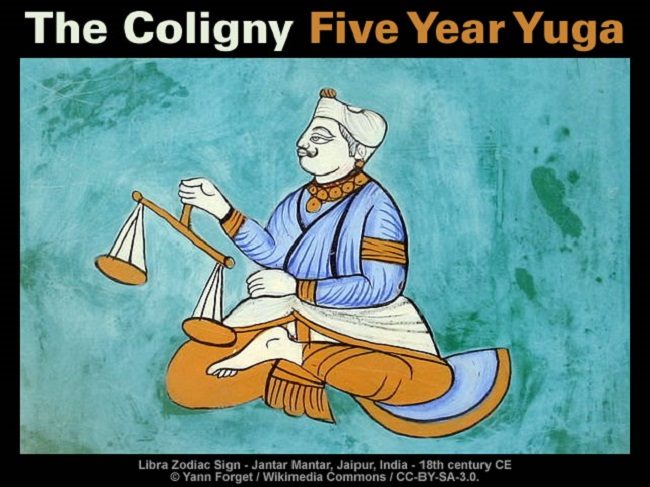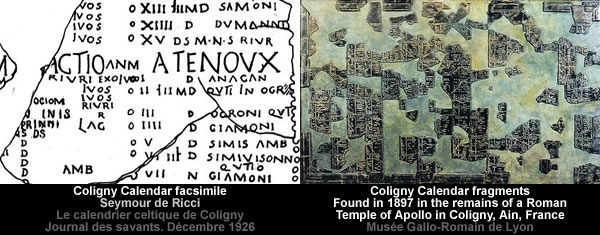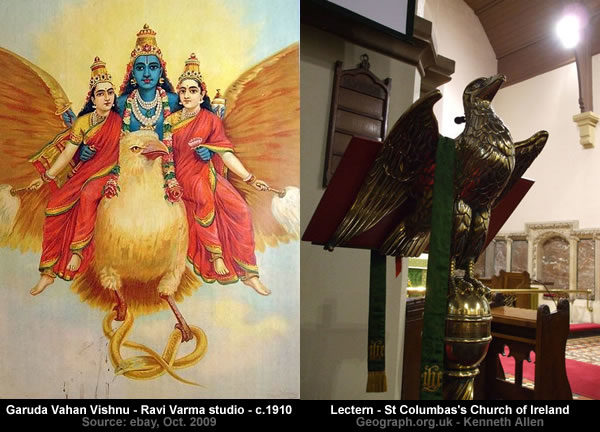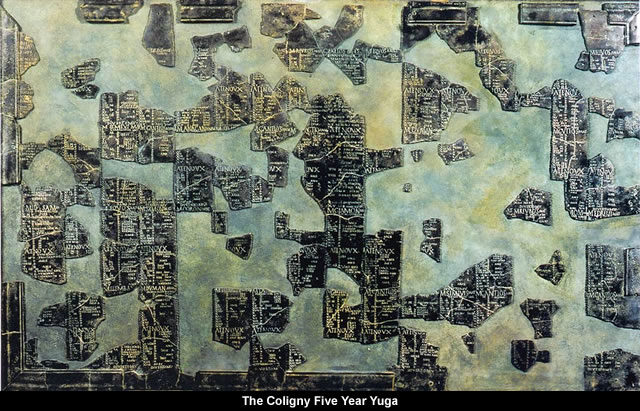The riddle wrapped up in an enigma is the 2nd century AD Coligny Calendar that contains 62 lunar months spread over five years.
The so-called "Calendar of Coligny" is a fragmented bronze plaque that was found in 1897 in the remains of a Roman Temple of Apollo in Coligny, Ain, France.Tracking down a solution for the Coligny Calendar begins by connecting the 12th century English New Year with the Indian New Year.
Coligny Calendar - Marc Carlson - 9 June 2004
http://www.personal.utulsa.edu/~marc-carlson/calendar/coligni.html
The restored tablet contains sixteen vertical columns, with 62 months distributed over five years.
https://en.wikipedia.org/wiki/Coligny_calendar
It shows 12 repeating units comprised of alternating 29 and 30 lesser units, and so appearing to correspond to the 13 lunar months of the solar year made up of 29 or 30 days.
Coligny Calendar - Marc Carlson - 9 June 2004
http://www.personal.utulsa.edu/~marc-carlson/calendar/coligni.html
See: https://malagabay.wordpress.com/2017/12/11/the-heinsohn-horizon-calendar-conundrum/
The first thing to be aware of is that, in England, from about the late 12th century until 1751 the civil, ecclesiastical and legal year began on 25 March, nearly three months later than the historical year.This Indian connection leads to a Vedic five-year lunar calendar in 300 AD.
Medieval English Genealogy - Chronology and Dating
http://www.medievalgenealogy.org.uk/guide/chron.shtml
Yet another proof of India having once ruled England is the fact that until 1752 A.D. the English New Year began on March 25.
That is the exact time of the year when the Indian New Year begins.
Some Missing Chapters Of World History - P N Oak
https://www.amazon.co.uk/dp/8188388270/
See: https://malagabay.wordpress.com/2016/07/17/catastrophic-english-christianity-as-a-vedic-cult-2/
History of the Indian CalendarWhich eventually leads to the Five Year Yuga calendar of 62 lunar month spread over years.
Early allusions to a lunisolar calendar with intercalated months are found in the hymns from the Rig Veda, dating from the second millennium B.C.
Literature from 1300 B.C. to A.D. 300, provides information of a more specific nature.
A five-year lunisolar calendar coordinated solar years with synodic and sidereal lunar months.
Calendars by L. E. Doggett
Explanatory Supplement to the Astronomical Almanac - Editor: P. Kenneth Seidelmann
https://eclipse.gsfc.nasa.gov/SEhelp/calendars.html#Indian
One of the distinguishing features of Vedanga Jyotisa is the use of a period of five years called yuga, which is different from the much larger period also called yuga, but which came into vogue much later in Indian astronomy in the Siddhanta period.The Five Year Yuga isn't totally precise as it drifts by ¾ of a day every year.
The five-year yuga of Vedanga Jyotisa consists of 62 candramasas (synodic months), 1830 days and 1860 tithis (l/30th part of a synodic month) and was taken to commence at the winter solstice.
A Note On The Five Year Yuga Of The Vedanta Jyotisa - B. N. Narahari Achar
Electronic Journal of Vedic Studies (EJVS) 3-4 (1997) pp. 21-28
https://archive.org/details/ANoteOnTheFiveYearYugaOfTheVedantaJyotisa
The Vedāṅga Jyotiṣa, or Jyotiṣavedāṅga is one of earliest known Indian texts on astronomy and astrology (Jyotisha).
The extant text is dated to the final centuries BCE, but it may be based on a tradition reaching back to about 700-600 BCE.
https://en.wikipedia.org/wiki/Vedanga_Jyotisha
Synodic month
This is the average period of the Moon's revolution with respect to the line joining the Sun and Earth.
The synodic month is the period of the Moon's phases, because the Moon's appearance depends on the position of the Moon with respect to the Sun as seen from the Earth.
https://en.wikipedia.org/wiki/Lunar_month
The Vedanga Jyotisa states in detail that in the yuga there are 5 solar years, 67 lunar sidereal cycles, 1830 days, 1835 sidereal days, 62 synodic months, 1860 tithis, 135 solar nakfatras, 1809 lunar nakfatras and 1768 risings of the Moon, all derivable from any three principal elements.But the Five Year Yuga is very practical because of its operational simplicity.
...
Accuracy of the Vedahga Jyotisa
We shall now proceed to examine the accuracy of the system, a much discussed affair.
The Vedanga Jyotisa says that there are 1830 civil days in the yuga, in which there are five
solar sidereal years and 62 lunar synodic months.
This gives 366 days for the year while it is really 365¼ days, known in the Vedic period before, as we have seen.
Vedanga Jyotisa of Lagadha - T. S. Kuppanna Sastry - 1985
https://archive.org/details/in.ernet.dli.2015.206186
Then, why this apparently absurd system?The remaining mystery seems to be how a Five Year Yuga ended up in the remains of a Roman Temple of Apollo in Coligny, Ain, France.
The answer is that it was meant primarily to provide a civil calendar, where convenience of division and ease of calculation is important.
The 1830 days period is divisible by 5, giving 366 days for the year.
This is divisible by 6, giving 61 days for each rtu (season).
The ayana has 183 days.
The two intercalary months, over the 60 normal months can come, one at the end of the 5th ayana and the other at the end of the 10th.
Vedanga Jyotisa of Lagadha - T. S. Kuppanna Sastry - 1985
https://archive.org/details/in.ernet.dli.2015.206186
The Coligny Five Year Yuga should be of great interest to Roman Historians.
But I'm not holding my breath.







Reader Comments
gold. fuckin idiots